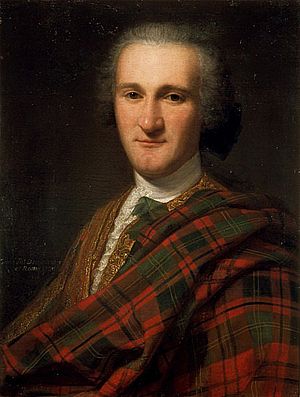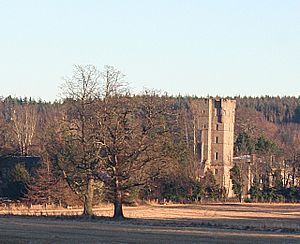John Drummond, 4th Duke of Perth facts for kids
Quick facts for kids
John Drummond
|
|
|---|---|

John Drummond, 4th titular Duke of Perth, painted in 1739 by Domenico Duprà
|
|
| Born | 1714 France |
| Died | 28 September 1747 Bergen op Zoom |
| Buried |
Convent of the English Nuns, Antwerp
|
| Allegiance | |
| Rank | Jacobite Lieutenant General |
| Unit | Regiment Roth, Irish Brigade; Jacobite Royal Scots |
| Battles/wars | War of the Austrian Succession 1745 Jacobite Rising Falkirk Muir Culloden |
| Relations | James Drummond, 2nd Duke of Perth (father) James Drummond, 3rd Duke of Perth (brother) |
John Drummond (1714–1747) was an important Scottish nobleman and soldier. He was known as the 7th Earl and 4th Duke of Perth, though these were "titular" titles, meaning they were recognized by some but not by the British government at the time. He was a strong supporter of the Jacobite cause, which aimed to bring the Stuart family back to the throne of Great Britain.
Drummond served as an officer in the French Army. However, he is most famous for his part in the Jacobite rising of 1745. During this rebellion, he was a senior officer and also led a special Scottish regiment called the Royal Scots, which he helped create in France.
Contents
Early Life and Family
John Drummond was born in France in 1714. He was the second son of James Drummond, who was known as the 2nd Duke of Perth. His family, the Drummonds, were Catholics and very loyal to the Stuart kings who had been removed from the British throne.
His grandfather, the 4th Earl of Perth, had gone into exile in France with King James II. There, James II's son, James Edward Stuart, gave him the title of Duke of Perth. John's father couldn't officially inherit the earldom because he had been involved in the Jacobite rising of 1715. However, the family still used these titles.
John and his older brother, James, grew up in Scotland at Drummond Castle in Perthshire. After their father died in 1720, they were sent to a school in France called the Scots College, Douai. John loved military subjects. He later joined the French army as an officer. He became a captain in the Regiment Roth, which was part of the Irish Brigade.
The Royal Scots Regiment
Serving as a soldier in a foreign army was common back then. However, many Scots didn't like serving in the Irish Brigade. So, the French government asked John Drummond to form a new Scottish regiment. This new group was called the Regiment Royal-Ecossais, or the Royal Scots. The idea was that this regiment could be used if France ever invaded Britain.
The order to create the regiment was given in December 1743. France declared war on Britain in March 1744. By December 1744, Drummond reported that the regiment was complete. It had 12 companies, with 55 men in each. Many of the soldiers were Scots or from Scottish families living in exile. The Royal-Ecossais also included some English and Irish soldiers who had left the British Army.
John Drummond and the 1745 Rising
In late 1745, John Drummond, his Royal Scots regiment, and other French soldiers sailed from Dunkirk to support the Jacobite rising of 1745. The British Navy tried to stop them, and many were captured. But Drummond and most of his regiment managed to get through during a storm. They landed at Jacobite-controlled ports in Scotland, like Montrose.
On December 2, Drummond announced that they had come to fight against the King of England. He took over as the main Jacobite commander in Scotland, leading about 3,000 men. At this time, the main Jacobite Army was marching south into England, heading towards Derby.
The Jacobite leaders were worried because they weren't getting much support from English Jacobites. They also hadn't seen any French troops land in England. When Drummond's message arrived, confirming his arrival and promising more French help, it made the leaders decide to turn back to Scotland. On December 5, they chose to retreat. Some people, like James Johnstone, later blamed Drummond for this decision, saying his promise of 10,000 more French soldiers was "inexcusable" and influenced the retreat.
Drummond wanted the Jacobite forces to meet in central Scotland. He said his French orders were to capture government-held forts first. He sent some of his soldiers to help Lewis Gordon fight against government troops. They won a battle at Inverurie in late December. The two Jacobite armies finally joined up on January 4, forming a force of about 9,500 men.
For the rest of the campaign, Drummond was a lieutenant-general. He commanded one of the army's main groups, alongside his brother James and Lord George Murray. At the Battle of Falkirk on January 17, he commanded the Jacobite left side. He was away scouting at the start of the battle, which might have affected how well his group supported Murray's attack. Despite this, Drummond fought bravely and even captured several prisoners himself. In March, Drummond was in charge of defending the Spey River against the government army. He set up his headquarters at Gordon Castle near Fochabers.
Drummond was known for being brave but also hot-tempered. He often argued with Lord George Murray and even with Charles Edward Stuart (Bonnie Prince Charlie) himself. Because he had lived in France for so long, he sometimes didn't understand Scottish customs. After retreating through Aberdeen, he supposedly suggested hanging some local church leaders. Some people also thought he wasn't a very skilled military leader, even though he was a general.
At the Battle of Culloden, Drummond commanded the center of the Jacobite line. After the Jacobites lost the battle, Drummond escaped Scotland on a French ship with other officers, including his brother James. James died on the ship on May 13 and was buried at sea. After this, John Drummond was called the 4th Duke of Perth. However, the government took away his family's Scottish estates because of his role in the rebellion.
When he arrived in France in June, he went to Versailles. He was the first to give the French court a clear report of the defeat at Culloden.
Later Life and Legacy
John Drummond died on September 28, 1747, during the siege of Bergen-op-Zoom. He got a fever while commanding soldiers in the trenches. Shortly before he died, he was promoted to major-general. He was buried in the chapel of an English convent in Antwerp. The convent buildings were sold in the 1790s, and his memorial was later lost.
John Drummond did not have any children. His uncle, also named John Drummond, became the next titular Earl and Duke of Perth.
| Peerage of Scotland | ||
|---|---|---|
| Preceded by James Drummond |
— TITULAR — Earl of Perth, Lord Drummond Jacobite peerage 1746–1747 |
Succeeded by John Drummond |
| — TITULAR — Duke of Perth, Marquess of Drummond, Earl of Stobhall, Viscount Cargill & Baron Concraig Jacobite peerage 1746–1747 |
||


